Microscope’s goal is to test the principle according to which in a vacuum all bodies fall at the same speed, whatever their mass. This principle first formulated by Galileo in the 17th century has been confirmed time and again, provided free fall is not subjected to atmospheric drag, for example. The reason is that gravity is the only force exerted on a body in free fall, but physicists are still unsure about how gravity behaves at smaller scales of matter: certain alternative theories attempting to unify gravitation and quantum physics predict that the principle of equivalence between gravitation and acceleration could be violated at very weak levels.
“Measurements of the equivalence principle have not been improved upon for 10 years,” says Isabelle Petitbon. “Theoretical physicists need experimental results to prove or disprove the hypotheses they are constructing. Microscope is going to provide them with fresh data for that.”
But why replicate free fall experiments in space at all? The main reason is because in Earth orbit, the Microscope satellite is able to create permanent free fall conditions. “It measures the positions of two proof masses housed inside a protective cocoon at the core of the satellite,” explains Pierre-Yves Guidotti. “After a year in orbit, Microscope has measured their free fall trajectory with extreme precision from 1,900 science orbits, a distance equivalent to half the Earth-Sun distance.”

Artist’s concept of the Microscope satellite in orbit 710 km above Earth since April 2016.
If the equivalence principle is violated, two masses of different atomic composition will tend to fall at different speeds. The level of precision required to measure their acceleration is 10-15 times Earth’s gravity: at such weak levels, it would take 5 million years to reach walking speed.
To achieve this kind of performance, the satellite has a drag-compensation system that uses microthrusters to correct for any forces interacting with free fall, such as residual molecules in the atmosphere at 710 km or photons from the Sun.
These technological innovations have enabled Microscope to test the equivalence principle with only 10% of data analysed so far and with a precision of 2.10-14 of Earth’s gravity, 10 times better than anything before. Tests previously performed on the ground have employed two very different methods. The first used a simple pendulum and then a torsion pendulum to obtain a precision of 10-12 g. The second has been firing laser beams since the 1970s at the five reflector panels left behind on the Moon by the Apollo mission astronauts and the Russian robotic Lunokhod 1 and 2 missions to continuously measure the distance and therefore free fall of our natural satellite with a precision of 10-13 g as it orbits the planet.
The first results from Microscope indicate no statistically significant violation of the principle with respect to the residual errors of the experiment: at 2.10-14 g, no breach in the theory of general relativity has been detected. These results were obtained from 120 of the 1,900 science orbits completed and the satellite will continue collecting data until March 2018 to further improve the mission’s performance and approach a final precision of 10-15 g.
So, what if the results at the end of the mission still confirm the theory of general relativity?
“If Microscope doesn’t detect any violation of the theory, that will further constrain some of the alternative theories predicting such a violation, thus advancing science,” says Isabelle Petitbon. “Looking further down the track, it’s likely that new ideas for experiments will be devised to attain yet higher levels of precision.”
Contacts
- Head of Fundamental Physics Programme: Isabelle Petitbon (isabelle.petitbon at cnes.fr)
- Exploitation Project Leader: Pierre-Yves Guidotti (pierre-yves.guidotti at cnes.fr)
More informations
- Microscope on the CNES Projects Library

Two of the four Microscope proof masses, made of platinum (left) and gold-plated titanium (right). Credits: ONERA